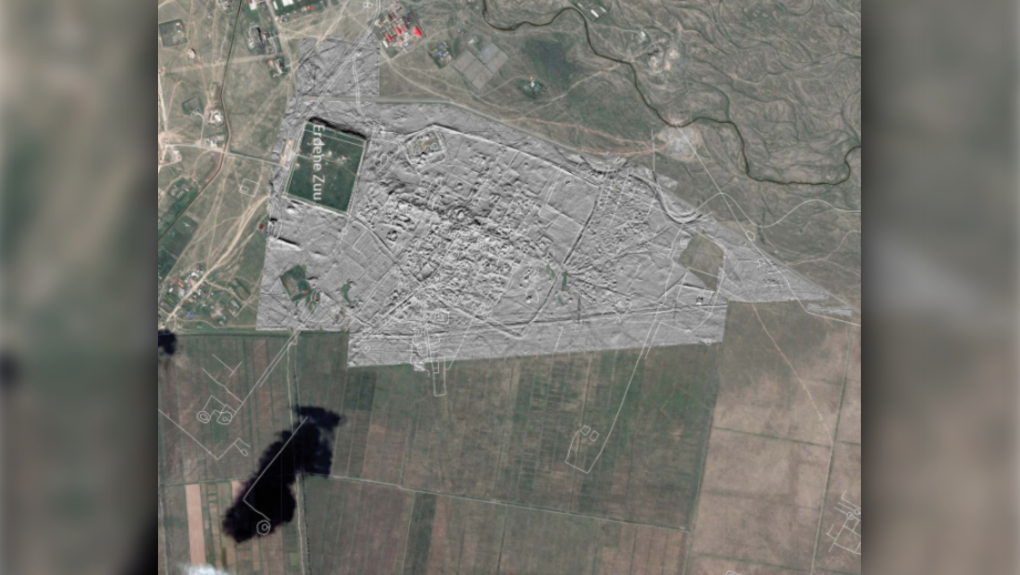TORONTO -
Archeologists have mapped the ancient Mongolian capital city of Karakorum in detail for the first time using geophysics, allowing them to reveal the layout, organization and size of the extensive settlement.
The study, published Thursday and featured in the February 2022 edition of the journal Antiquity, details efforts to uncover the breadth of the city, first founded on the Mongolian plateau in the 13th century by the son and successor of Genghis Khan, Ogodei.
The city fell into disuse by the early 15th century and was rediscovered in 1889.
An eyewitness account cited by the study and written in 1254 by Franciscan friar William Rubruck, an envoy of King Louis IX of France, describes an enclosed city with four gates and home to Chinese artisans, Muslim merchants and captives across the vast Mongol empire.
Ogodei and his successor Mongke Khan would stay in the city twice a year for an extended period, the study says.
Ogodei encouraged the Mongol empire’s elite to build houses near his palace and the city was the destination for numerous foreign legations and long-distance traders. It was also the home of forcibly relocated craftspeople and prisoners of war.
After the dissolution and splicing of the Mongol empire in 1260 into the Yuan Empire, Ilkhanate, Chaghatayid Khanate and Golden Horde, Khubilai Khan established the capital of the Yuan Empire at Dadu, modern day Beijing.
Karakorum retained its importance, however, as the administrative centre of the region north of the Gobi Desert.
When the Yuan Empire fell in 1368, the city became the destination and seat of fugitive members of the Yuan Dynasty, but began falling into dereliction at the beginning of the 15th century, the study says.
A Buddhist monastery known as Erdene Zuu was built in 1586 on the ruins of the walled palace area.
It was rediscovered by explorer and archeology Nikolai Yadrintsev in 1889, and further expeditions in 1891 produced the first map of the area, though the study notes it is basic.
Subsequent expeditions by German, Russian, Mongolian and Japanese teams have limited their mapping efforts to the walled areas and buildings in front of Karakorum’s eastern gate, despite aerial photographs from the 1970s clearly showing the settlement extended far beyond that.
The plateau where Karakorum was built was often considered a pastoral ecozone home to nomads, the study says, but the area is rich in monuments, permanent structures, fortifications, monasteries and large cities that have remained untouched since they were abandoned.
This makes the area ideal for remote sensing. Without having to dig, archeologists mapped the road layout and neighbourhoods of the city using magnetic and topographical data with aerial photographs, pedestrian survey and historical sources, revealing the city was larger than previously expected.
By using a motorized measurement device that allowed the recording of magnetic and topographic data at high resolution simultaneously, known as “SQUID” or Superconducting Quantum Interference Device sensor array, researchers combed over 465 hectares in 52 days during two campaigns in 2016 and 2017.
Because of the complexity of the SQUID sensors, the study says, the calculation of how deep objects lie and 3D modelling of their shape is possible. However due to the high density of magnetic signatures – especially within the city centre – thousands of “hits” needs to be calculated and classified.
The new map created from the study confirms the researchers’ hypothesis that the city stretched far beyond the areas documented since the 1930s, with archeologists documenting 259 sites that cover several time periods. More than 200 of those sites are denoted by artefacts, 61 per cent of which dated to the Mongol period.
The study also revealed for the first time distinct zoning within Karakorum, with the south and west sides of the city being dominated by compounds of various sizes with coloured, glazed roof tiles and granite column bases, which researchers posit were for elite members of the empire, administration and ritual activities.
By combining older data with modern satellite images and their own measurements, archeologists were able to trace the main road from the eastern gate of Karakorum for approximately three kilometres.
The roads were noted in Rubruck’s eyewitness account from 1254. Both sides of the road were lined by buildings over long stretches, and a second road was found that possibly served the palace district, which eventually merged with the original eastern gate road and lead towards China.
Two paths from the western gate end at an ancient tributary of the Orkhon River, and because no structures for water supply have been discovered, it is thought that water from the river was carted into Karakorum in storage vessels or leather bags, the study says.
Researchers note that the 13th-century observations of Rubruck informed later historians and archeologists alike, however it was highly Eurocentric which did not do the city justice, the study says.
The combination of large-scale and high-resolution surveys in the study reveals that the city had no clear limits, with built areas becoming less dense with distance from its centre.
The different types of buildings visible in the high-resolution map allowed researchers to posit for the first time that there was a division of the city into different neighbourhoods and by using the new map of the city, archeologists and historians can hypothesize about the significance of the various access roads, giving more context into what daily life was like.
This large-scale, systematic exploration of the city will allow researchers to adjust their expectations about Mongolian steppe urbanism, and provides a basis for further archeological excavations and non-destructive surveys.










































